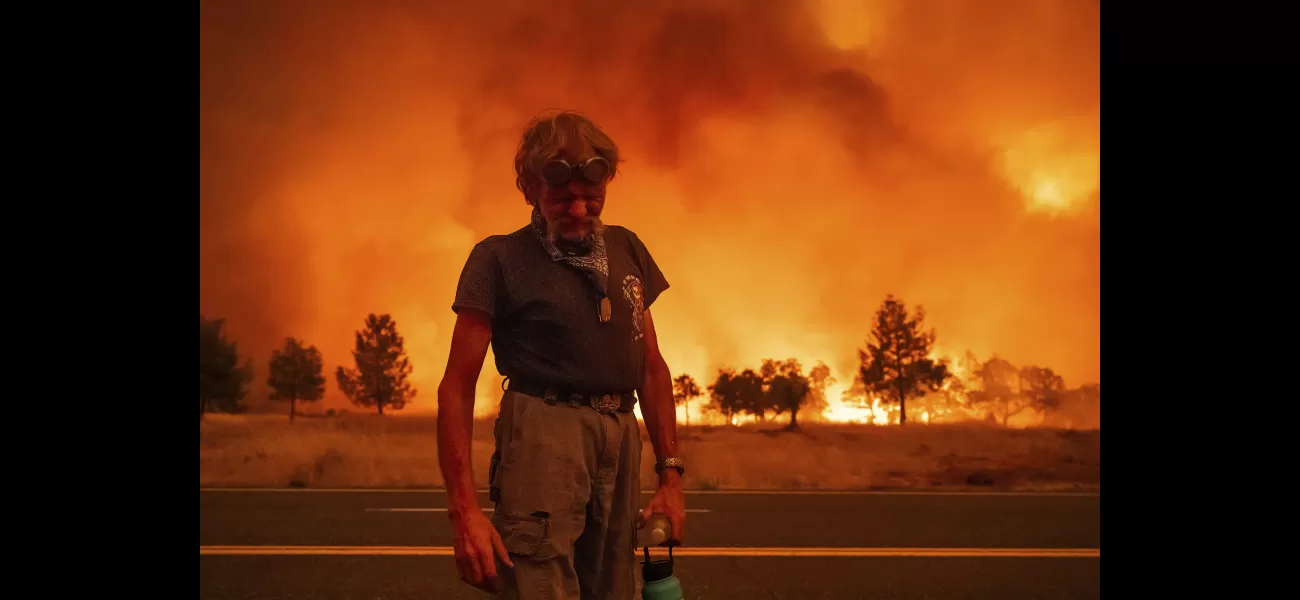Thousands of people are fighting wildfires in the Western region, while millions are affected by poor air quality due to the smoke.
Massive wildfires in western US and Canada prompt air quality warnings and involve thousands of firefighters, with California facing its biggest blaze.
July 28th 2024.

On a sunny Sunday morning, millions of people in the western United States and Canada were issued air quality alerts due to the raging wildfires that had been blazing across the region. As firefighters worked tirelessly to contain the flames, the largest wildfire of the year in California, known as the Park Fire, had already consumed over 550 square miles of land in the inland Northern California area.
The thick smoke and haze from the fire had caused poor air quality in a large portion of the Northwestern U.S. and western Canada. Despite the efforts of the thousands of firefighters on the ground, the fire was only 12% contained. However, there was hope that the cooler temperatures and higher humidity in the forecast could aid in the battle against the blaze.
The Park Fire, which has been compared to the devastating 2018 Camp Fire that claimed 85 lives and destroyed 11,000 homes in the nearby community of Paradise, was now threatening other Butte County communities. Evacuation warnings had been issued for Paradise and several other areas on Sunday.
According to Jay Tracy, a spokesperson for the Park Fire headquarters, the initial focus of the first responders was to save lives and protect property. But now, their main goal was to directly confront the fire. Tracy also mentioned that reinforcements were on the way to provide much-needed rest for the local firefighters, who had been working tirelessly since the fire started on Wednesday.
"This fire has taken many by surprise with its explosive growth," Tracy said. "It is unlike anything we've experienced before."
Even though the weather in the area was expected to be cooler than usual for the next few days, meteorologists warned that existing fires would not simply disappear. Marc Chenard, a meteorologist at the National Weather Service, explained that climate change has led to an increase in lightning strikes, which can easily spark new fires in the hot and dry conditions.
As the Park Fire raged on, it was just one of over 100 wildfires burning in the U.S. on Sunday, according to the National Interagency Fire Center. Many of these fires were caused by the severe weather conditions, as the Western U.S. continued to experience scorching heat and drought.
Despite the improved conditions in Northern California, the National Weather Service issued a "red flag" warning for parts of Utah, Colorado, and Wyoming, as well as parts of California, indicating the potential for more fires to ignite. In Southern California, a fire in the Sequoia National Forest had already destroyed over 48 square miles of land and forced the evacuation of a small community called Havilah.
Meanwhile, in eastern Oregon and eastern Idaho, officials were assessing the damage caused by a group of wildfires known as the Gwen Fire. As of Sunday, the fire had spread over 41 square miles of land.
Reporting from San Francisco, AP journalist Martha Rodriguez was joined by colleagues from around the country, including David Sharp, Becky Bohrer, John Antczak, Rio Yamat, David Sharp, Holly Ramer, Sarah Brumfield, Claire Rush, Terry Chea, Scott Sonner, Martha Bellisle, and Amy Hanson, who all contributed to this report. Stay updated on the latest news from Colorado by signing up for our Mile High Roundup email newsletter.
The thick smoke and haze from the fire had caused poor air quality in a large portion of the Northwestern U.S. and western Canada. Despite the efforts of the thousands of firefighters on the ground, the fire was only 12% contained. However, there was hope that the cooler temperatures and higher humidity in the forecast could aid in the battle against the blaze.
The Park Fire, which has been compared to the devastating 2018 Camp Fire that claimed 85 lives and destroyed 11,000 homes in the nearby community of Paradise, was now threatening other Butte County communities. Evacuation warnings had been issued for Paradise and several other areas on Sunday.
According to Jay Tracy, a spokesperson for the Park Fire headquarters, the initial focus of the first responders was to save lives and protect property. But now, their main goal was to directly confront the fire. Tracy also mentioned that reinforcements were on the way to provide much-needed rest for the local firefighters, who had been working tirelessly since the fire started on Wednesday.
"This fire has taken many by surprise with its explosive growth," Tracy said. "It is unlike anything we've experienced before."
Even though the weather in the area was expected to be cooler than usual for the next few days, meteorologists warned that existing fires would not simply disappear. Marc Chenard, a meteorologist at the National Weather Service, explained that climate change has led to an increase in lightning strikes, which can easily spark new fires in the hot and dry conditions.
As the Park Fire raged on, it was just one of over 100 wildfires burning in the U.S. on Sunday, according to the National Interagency Fire Center. Many of these fires were caused by the severe weather conditions, as the Western U.S. continued to experience scorching heat and drought.
Despite the improved conditions in Northern California, the National Weather Service issued a "red flag" warning for parts of Utah, Colorado, and Wyoming, as well as parts of California, indicating the potential for more fires to ignite. In Southern California, a fire in the Sequoia National Forest had already destroyed over 48 square miles of land and forced the evacuation of a small community called Havilah.
Meanwhile, in eastern Oregon and eastern Idaho, officials were assessing the damage caused by a group of wildfires known as the Gwen Fire. As of Sunday, the fire had spread over 41 square miles of land.
Reporting from San Francisco, AP journalist Martha Rodriguez was joined by colleagues from around the country, including David Sharp, Becky Bohrer, John Antczak, Rio Yamat, David Sharp, Holly Ramer, Sarah Brumfield, Claire Rush, Terry Chea, Scott Sonner, Martha Bellisle, and Amy Hanson, who all contributed to this report. Stay updated on the latest news from Colorado by signing up for our Mile High Roundup email newsletter.
[This article has been trending online recently and has been generated with AI. Your feed is customized.]
[Generative AI is experimental.]
0
0
Submit Comment





